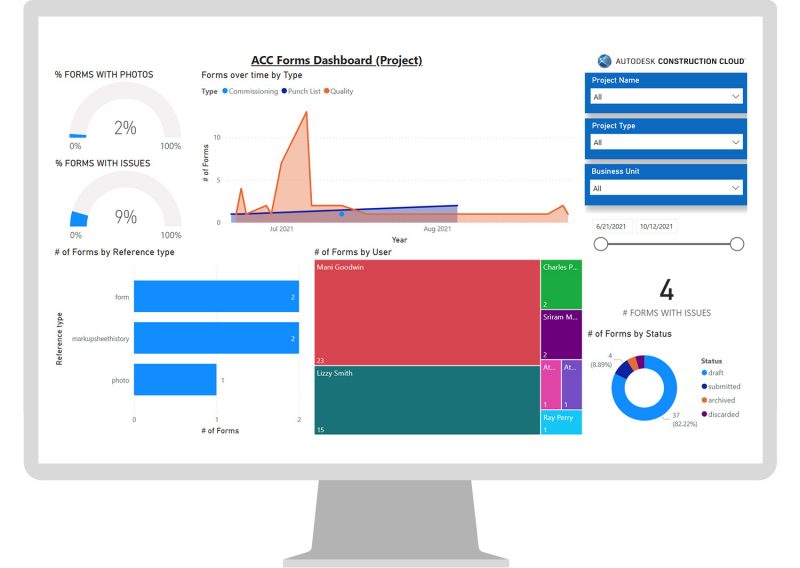The Latest Across Autodesk Construction Cloud Unified Platform, Autodesk Build, Autodesk BIM Collaborate, Autodesk Takeoff, BuildingConnected, BIM 360, and Assemble
We spend a lot of time listening to customers so we can build the products and incorporating the features you need most. Our team has been hard at work, and thanks to your feedback on the user experience, I’m excited to share over 35 new feature releases and enhancements across Autodesk Construction Cloud products.
From ensuring project schedule detail is always visible no matter where you are, to faster resolution of design discrepancies with deeper issue tracking, the latest product updates within Autodesk Construction Cloud can be found below.
Jump to releases by product:
Autodesk Construction Cloud Unified PlatformAutodesk BuildAutodesk BIM CollaborateAutodesk TakeoffBuildingConnectedBuildingConnected ProBid Board ProTradeTappBIM 360Assemble
utodesk Construction Cloud Unified Platform

* = features on both Autodesk Construction Cloud Unified Platform & BIM 360
PI | App Gallery
The App Gallery allows Account Admins to easily connect Autodesk Construction Cloud platform products with third-party apps such as augmented reality tools, jobsite cameras or scheduling applications. The App Gallery allows users to explore and discover a range of integration solutions that leverage the Forge open platform for seamless data flow.
dministration | Limit Project & Template Creation to Account Admins
Autodesk Construction Cloud Unified Platform users can now limit the creation of new projects and new project templates to only Account Admins. This restriction creates more control, improves standardization, and ensures the unnecessary creation of duplicate projects or project templates.
dministration | Product Display List in Project Admin & Members Pages
Project Admins will now only see the products they have purchased as options to assign to members. This will avoid potential confusion of which products or licenses are available to use. Additionally, Account Admins will have the option from this screen to purchase or add additional products.
dministration | UI Updates to Project List Page
Users can now see additional links to other Autodesk Construction Cloud products in the top of the project list page. The addition of these links will help teams save time with the ability to easily access other Autodesk Construction Cloud products like BuildingConnected and TradeTapp.
Document Management | Search Reviews and Transmittals by Name
You now have access to a new search bar at the top of the Reviews and Transmittals pages. By inputting a keyword in the search bar, users will be able to search through all Reviews and Transmittals to quickly find what they’re looking for.
Document Management | Hypermodel Viewing and Alignment
Users will now get a better understanding, and visualization, of their 2D drawings and 3D Models with hypermodel viewing and alignment. Users can choose 2D drawings to position on top of a sectioned 3D model to align and seamlessly navigate between.
Document Management | Holding Area Update
Previously, files in the Holding Area were split into batches based on upload group with a time/date stamp. The Holding Area will now show all files in a single list and will be sortable by columns so Admins can easily review, edit, and approve.
Document Management | Custom Attributes Enhancements *
You now have better document control with custom attribute enhancements. For example, Custom Attributes with text fields now have character type and character limit constraints. In addition, Admins have the ability to edit custom attributes that already have data associated with them.
Dashboards | Additional Partner Cards
Both Autodesk Construction Cloud Unified Platform and BIM 360 users will now see new partner cards for Google, Airtable, Join.BUILG , Stevenson Systems, EmbneusysField Control AnalyticsLambertssonOpticVyuProgressCenterProNovosQuickbaseSafe Site Check InSignOnSiteStructShareTopBuilder, and WakeCap
utodesk Build
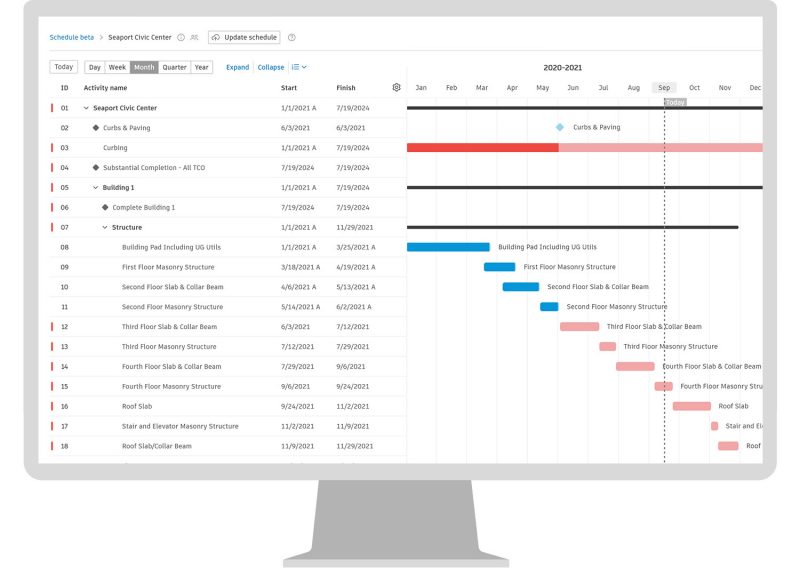
** = features in both Autodesk Build & BIM 360
*** = features in Autodesk Build, Autodesk BIM Collaborate & BIM 360
Schedule Tool
Autodesk Build’s Schedule Tool is now available for all Autodesk Build users! Schedules uploaded from Primavera P6, Microsoft Project, and ASTA Powerproject can be imported to a Build project and displayed in a Gantt chart or calendar view.
Create custom views that display desired schedule items with the filter function, allowing users to look three weeks ahead or behind the current schedule. Share the schedule with field teams so they can comment on specific activities and link references to each activity item. References include photos, files, sheets, assets, and issues. Users can also integrate Schedule with Cost in Autodesk Build to improve budgeting and planning for schedule-related costs.
Get all the details on the new Schedule Tool in this blog post [coming soon].
Data Connector | Forms Data & Power BI Template
Coming early October. Autodesk Build users can now extract Forms data using the Data Connector as well as leverage a new Power BI Template. This will help improve visibility into how teams are using forms, an overview of the status of forms, and highlight any issues that need to be addressed.
Data Connector | Updates to Document Management & Assets Power BI Templates **
There is now a new Document Management Power BI Template that includes formats for both csv and compatibility with the Power BI Connector tool. Additionally, there is a new Asset Power BI Template that is compatible with the Power BI Connector tool.These templates help teams start to create custom dashboards that align more to their company KPI’s while using easy out-of-the-box options.
Templates | Adding Form Templates from Account Library
Account Admins will now see the ability to add a form template directly to a project template. This can be created within the account level library. This expands on the standardization capabilities ensuring that teams are always inputting the right data via the most up-to-date templates.
Meetings | Microsoft Teams Integration ***
Autodesk Build and BIM Collaborate users will now be able to add a Microsoft Teams meeting link directly from the meeting. This helps to enable more collaboration between project teams as users can now choose between Zoom and a Microsoft Teams collaboration toolsets.
RFIs | Email mechanism for project team members
Coming early October. Project team members can now reply to RFIs directly from the email notification, without logging into the platform. If a team member has a ball-in-court, their response will be noted as the official response and the RFI will automatically move to the next step in the process. This increases collaboration, streamlines the process, and helps improve the response time for RFIs.
RFIs | Enhanced References
Autodesk Build users can add additional references including submittals, forms, assets, and schedule items. When referencing RFIs in other tools, such as Issues, users will be able to search and filter across all RFIs, making it easy to connect workflows within Build.
RFIs | View and edit custom fields on mobile
Autodesk Build users can now view and edit custom fields, within RFIs, directly from their mobile devices.
RFIs | Quick List Action / Three dot menu
Autodesk Build users can now perform quick RFI actions from the RFI menu within the RFI log. These actions include: duplicate RFI, sending a reminder email to the RFI ball-in-court, and exporting the RFI.
Submittals | View linked markups on mobile
Autodesk Build users can now view linked submittals directly from markups on their iOS and Android advice. This ensures that all team members, especially those in the field, have access to important project documents.
Cost Management | Connection to Locations**
Autodesk Build and BIM 360 Cost Management users can now connect a location to budget and change order items. This feature allows teams to see how much money is allocated to specific areas in the building, and have a location-based view of changes. This provides a powerful way to track patterns to mitigate risk and potential cost overruns.
Cost Management | Cost Payment Applications Custom Approval Workflows**
Autodesk Build and BIM 360 Cost Management users can now utilize the decision-based workflow engine to create custom workflows to automate the internal review and approval process of cost payment applications.
Forms | Forms Tab UI Revamp on Mobile
Coming soon. The Forms tab UI will be revamped to offer a more convenient experience to mobile users. With this improvement, finding and quickly editing form drafts becomes easier for the field team. The update includes a new“At a glance” view and searching and filtering options.
Photos | Locations
Users will have the ability to add a location to a photo. Linking jobsite photos to predefined project locations will help teams further standardize the way they collect and organize their data.
Learn more about this month’s product releases specific to Autodesk Build in this blog post.
utodesk BIM Collaborate
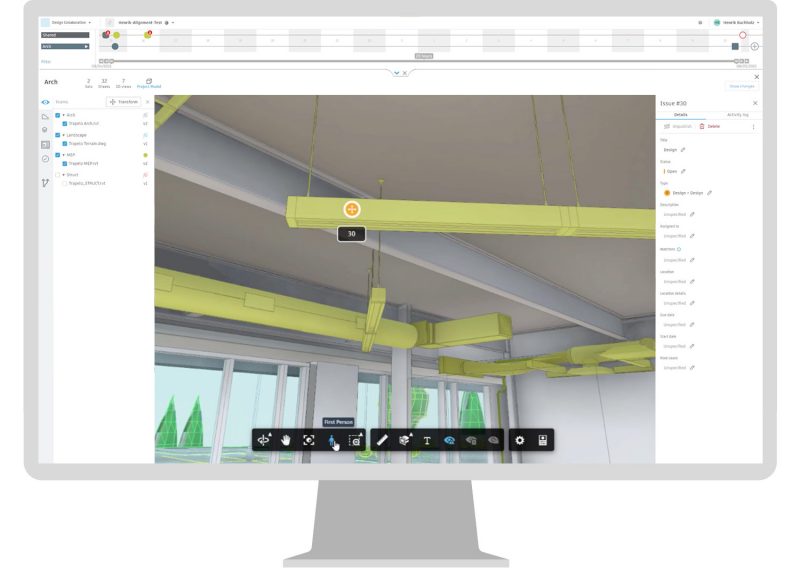
Design Collaboration | Design Issues
Design issues in Autodesk BIM Collaborate help teams communicate and resolve design discrepancies in 2D and 3D by detailing the who, what, and where—all in the same environment where design packages are created and reviewed.
Issues in design collaboration use the same communication solution as is used in coordination workflows, field workflows, and the Revit add-in, making it easy to assign and resolve issues in whichever tool is necessary to get the job done.
Upfront issue communications create higher quality designs and have a cascading effect on downstream workflows, making the job of the BIM manager and the project manager all that much easier.
Get all the in-depth details on the new Design Issues feature in this blog post [coming soon].
Design Collaboration | Team Content Folders
Each team on a project can now define which folders they’d like to see in their team space. The team content folders will only show the selected sub-folders for quicker access to the most relevant models, sheets, and pdfs. Permissions can be assigned for each team folder as well as creating an exclusive coordination space for that team’s models is quick and easy. With fewer files to load, teams gain speed and efficiency in the package creation process
utodesk Takeoff
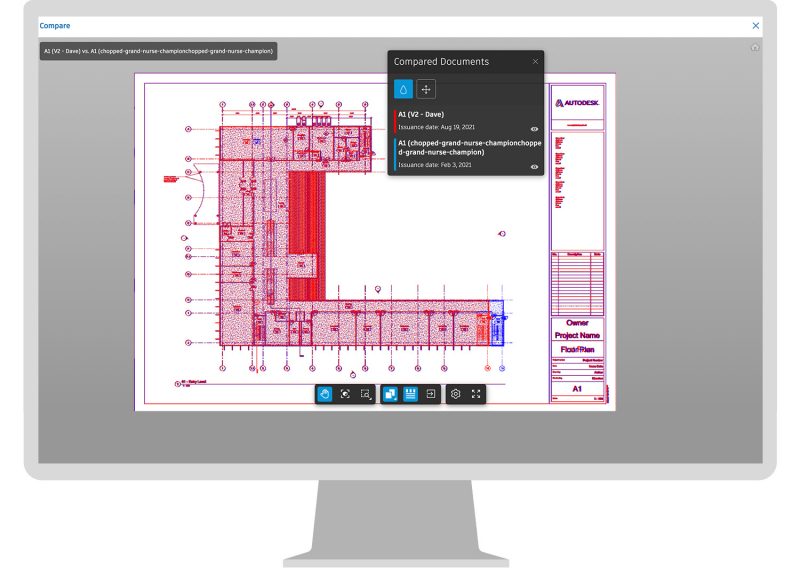
File Compare
Users can now compare PDF versions directly in Autodesk Takeoff without the need to run the compare in Autodesk Docs. This helps streamline change management and creates a smoother takeoff process. Users can either compare files side by side or use the overlay option.
BuildingConnected
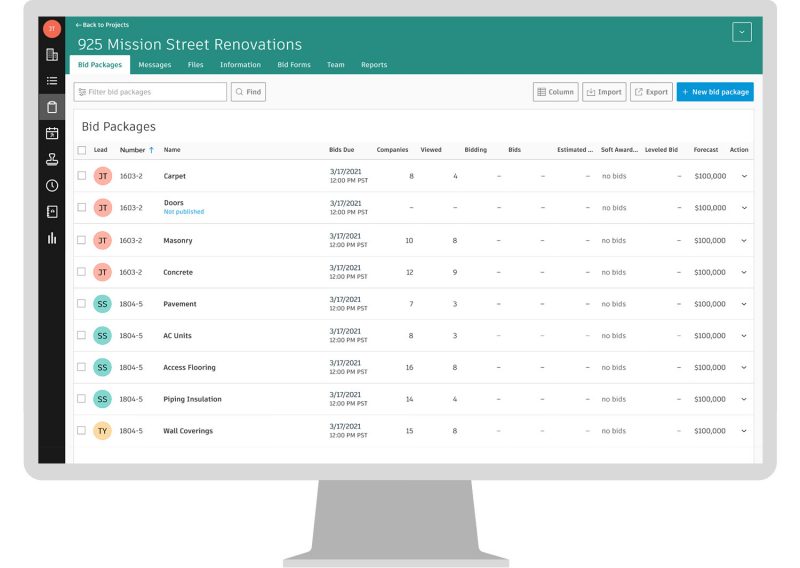
BuildingConnected Pro
Updated Look and Feel
Coming soon. Users can now experience an updated look and feel with new typography and colors in BuildingConnected Pro. Product functionality remains the same.
New Proposals API Endpoint
For users that use BuildingConnected Pro’s API, there is a new API endpoint available for proposals submitted. Information such as line item descriptions, unit costs, total cost, and revisions are available to use.
Bid Board Pro
Updated Look and Feel
Coming soon. Users can now experience an updated look and feel with new typography and colors in Bid Board Pro. Product functionality remains the same.
TradeTapp
Expanded Auto-Renewals
Users can now configure vendor auto-renewals to send based on qualification status expiration, financial statement expiration, and/or certificate of insurance expiration.
BIM 360
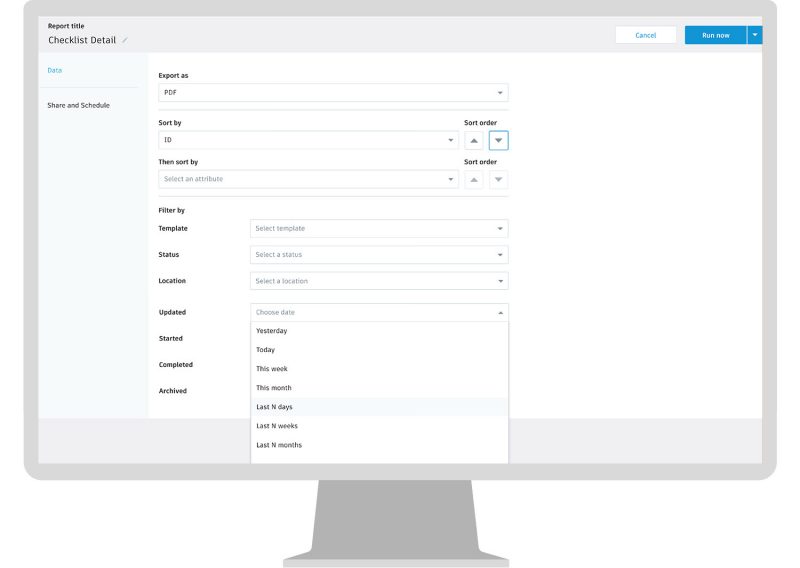
Reports | Display Asset Detail in Checklist Report
Coming early October. The Checklist Detail Report in BIM 360 will now include details about assets that are referenced back to a checklist. This will give users access to any relevant asset data so they can save time by addressing issues quickly during inspections.
Reports | Checklist Report Filter Enhancement
BIM 360 users will now see a new “Updated” filter option for the Checklist Detail and Checklist Summary reports. This allows users to select a timeframe for showing checklists that have been updated within a specified time range. This also gives users the ability to create more relevant reports with more specific data.
Checklists | Offline Checklist Creation
Coming early October. BIM 360 mobile users will be able to create a checklist even when their phone doesn’t have an internet connection. Thanks to this feature, even if field teams need to work on sites with no internet connection, they can still start filling out checklists which will sync up to the cloud once they are back online.
Checklists | Filter by Creation Date
BIM 360 users can now filter checklists based on their creation date by using the new “Created On” filter. Thanks to this new filter, project members who need to review checklists created within a certain time frame, can quickly find what they are looking for.
Checklists | Attach Document from Local Drive
Coming soon. Similar to RFIs and Issues, BIM 360 users will be able to attach a document from their local drive to a checklist as well. The document will be stored as an attachment to the checklist only, it won’t show up among the project files.
Submittals | Reporting and Submittal Enhancements
All BIM 360 users will now be able to create reports and filter submittal items by sub-status and due date, increasing transparency and connectivity. Users will also be able to export search results and leverage the new XLSX export format within the submittals overview tab.
ssemble
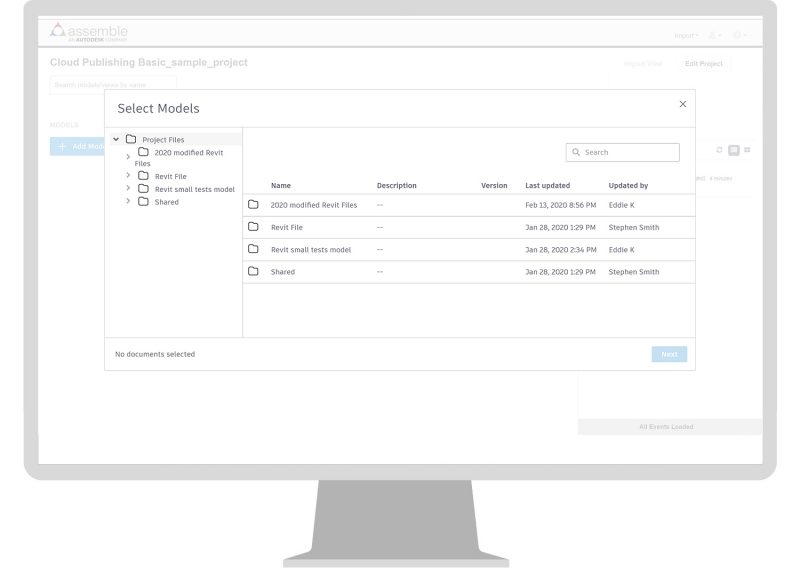
Model Publishing Enhancements
Assemble users can now publish Revit models directly from Autodesk Docs and BIM 360 Docs to Assemble without the need of Revit add-in. This greatly reduces duplication of efforts by leveraging the common data environment. It also helps ensure everyone is working from the latest project documents.
Stay in the Know for More Autodesk Construction Cloud Product Updates

The post 35+ New Product Updates for Autodesk Construction Cloud appeared first on Digital Builder.














